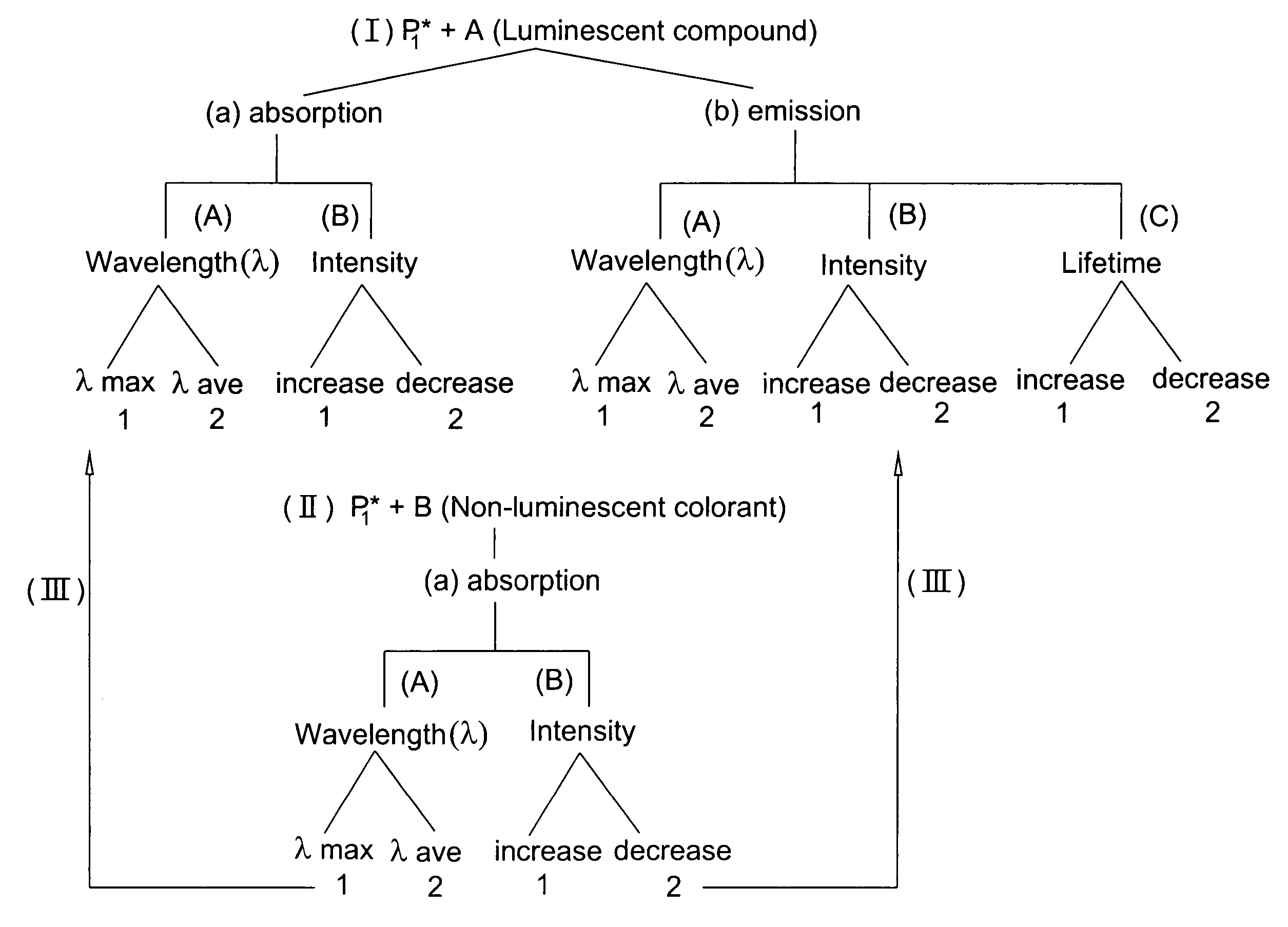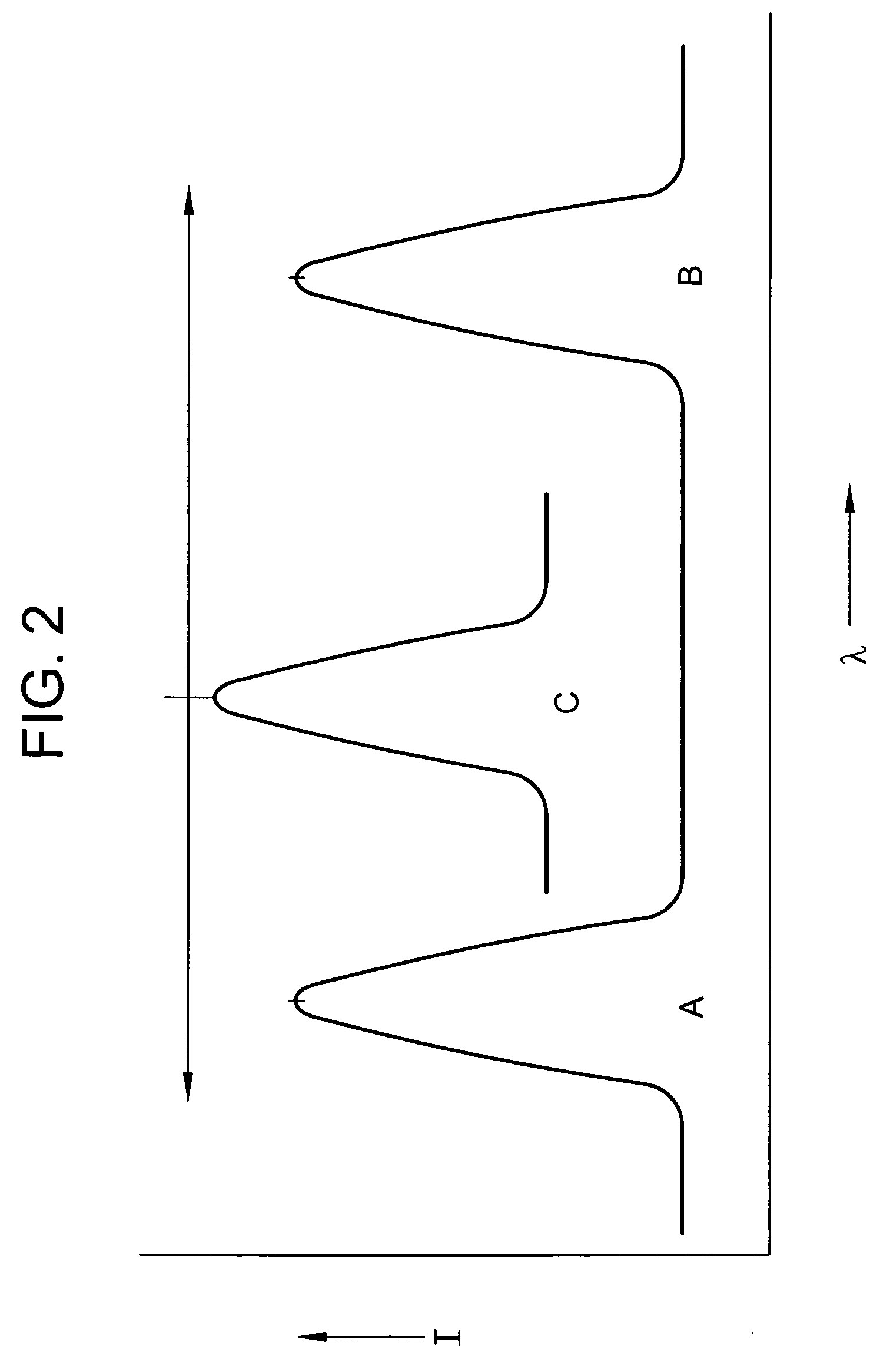Ink jet ink composition and method for security marking
a technology of ink jet and composition, applied in the field of ink jet ink composition, can solve the problems of inability to read or reproduce information contained in the mark, inability to meet the requirements of automatic processing, etc., and achieve the effect of altering an absorption and/or emission characteristi
- Summary
- Abstract
- Description
- Claims
- Application Information
AI Technical Summary
Benefits of technology
Problems solved by technology
Method used
Image
Examples
example 1
[0121]This Example illustrates the use of cationic photoinitiators as energy active compounds and the change in luminescence upon irradiation with UV energy. A resin solution, designated Solution 1, was made by dissolving 100.0 g of the styrene acrylic copolymer JONCRYL ™611 (Johnson Polymers) in 400.0 g of acetone. Dye solutions were by dissolving approximately 1% of the luminescent europium organocomplex dye LUMILUX CD-331 in Solution 1. To each of these solutions, a different energy active compounds was added. These solutions are summarized in Table 19.
[0122]
TABLE 19Solution 1LUMILUXSolution(%CD-331 (%Additive Name andNumberweight)weight)Amount (% weight)2991None39415% Mixed triarylsulfoniumsalt (UVI-6976)a49415% Diaryliodonium salt (CGI-552)b59415% Tetrabutylphosphoniumbromide (TBPBr)c6 89*15% Tetraphenylphosphoniumbromide (TPPBr)*,c79415% Benzophenone (BP)c89415% Darocur 1173 (1173)b99415% Darocur TPO (TPO)b10941Lauric acidc*5% ethanol replaced 5% of the Solution 1 to solubiliz...
example 2
[0128]This Example illustrates the use of halogenated photoacid generators as energy active compounds and the change in luminescence upon irradiation with UV energy. Several more representative solutions were prepared as in Example 1. Dye solutions were made by dissolving approximately 1% of the luminescent europium organocomplex dye LUMILUX CD-331 (Honeywell Corp.) Solution 1. To each of these solutions, a different energy active compound was added. These solutions are summarized in Table 21.
[0129]
TABLE 21LUMILUXSolutionSolution 1CD-331Additive Name andNumber(% weight)(% weight)Amount (% weight)119415% 1,2-dibromocyclohexane(DBCH)a129415% 1,10-dibromodecane (DBD)a139415% tribromoethanol (TBE)a149415% tribromoneopentyl alcohol(TBPA)a15941PerfluoroheptaneaaAldrich, Inc.
[0130]The solutions in Table 21 were subject to the same light exposure and analyses conditions as demonstrated in Example 1. The results are given in Table 22.
[0131]
TABLE 22Percent remainingluminescence after 2minutes...
example 3
[0133]This Example illustrates the use of certain non-ionic photoacid generators as energy active compounds. Several more representative solutions were prepared as in Example 1. Dye solutions were made by dissolving approximately 1% of the luminescent aeropium organocomplex dye Lumilux CD-331 (Honeywell Corp.) in Solution 1. To each of these dye solutions, a different energy active compound was added. These solutions are summarized in Table 23.
[0134]
TABLE 23LUMILUXSolutionSolution 1CD-331 (%Additive Name andNumber(% weight)weight)Amount (% weight)169415% [1,2,3-trismethanesulfonate]benzene(PYR-100)a179415% diazomethane compound(DAM-301)a189415% succinimidyl sulfonateester (SI 105)a199415% tris[trichloromethyl]s-triazine (TAZ 100)a209415% sulfonated nitride (CGI-263)baMidori Kogaku, Inc. Ltd.bCGI-263 from Ciba Specialty Chemicals
[0135]The solutions in Table 23 were subject to the same light exposure and analyses conditions as demonstrated in Example 1. The results are given in Table ...
PUM
| Property | Measurement | Unit |
|---|---|---|
| sonic velocity | aaaaa | aaaaa |
| viscosity | aaaaa | aaaaa |
| sonic velocity | aaaaa | aaaaa |
Abstract
Description
Claims
Application Information
 Login to View More
Login to View More - R&D
- Intellectual Property
- Life Sciences
- Materials
- Tech Scout
- Unparalleled Data Quality
- Higher Quality Content
- 60% Fewer Hallucinations
Browse by: Latest US Patents, China's latest patents, Technical Efficacy Thesaurus, Application Domain, Technology Topic, Popular Technical Reports.
© 2025 PatSnap. All rights reserved.Legal|Privacy policy|Modern Slavery Act Transparency Statement|Sitemap|About US| Contact US: help@patsnap.com



